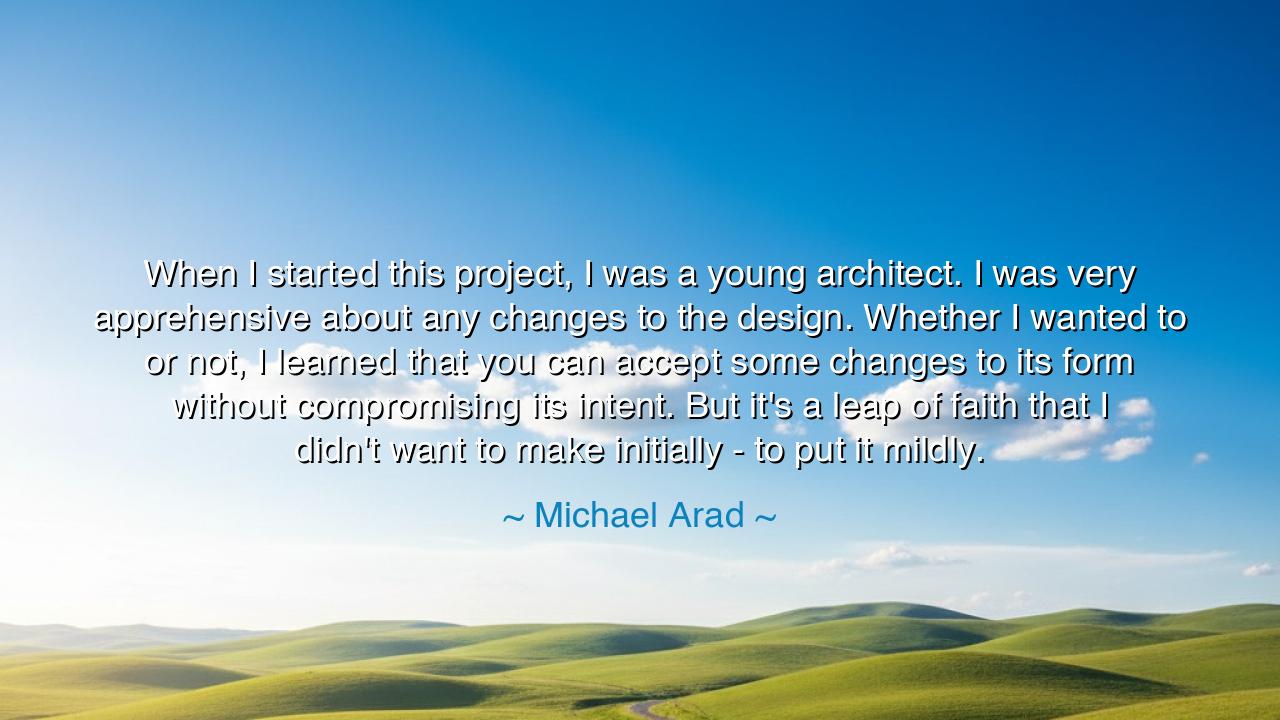
When I started this project, I was a young architect. I was very
When I started this project, I was a young architect. I was very apprehensive about any changes to the design. Whether I wanted to or not, I learned that you can accept some changes to its form without compromising its intent. But it's a leap of faith that I didn't want to make initially - to put it mildly.






The words of Michael Arad—“When I started this project, I was a young architect. I was very apprehensive about any changes to the design. Whether I wanted to or not, I learned that you can accept some changes to its form without compromising its intent. But it's a leap of faith that I didn't want to make initially—to put it mildly.”—speak with the humility of a creator who has wrestled with both vision and surrender. They were born from his journey as the designer of the 9/11 Memorial in New York City, a project that demanded not only architectural brilliance but spiritual depth. These words are not about buildings alone—they are about the eternal tension between control and trust, between the purity of vision and the wisdom of acceptance.
To create is to dream of perfection. Every artist, writer, builder, or leader begins with an image in the mind—a form of what should be, unmarred by compromise or interference. Arad, when he first conceived his design, saw the memorial as something sacred and precise, a reflection of his own heart. Yet as the project evolved, it met the realities that all great works face: the demands of others, the constraints of time, politics, and the physical world itself. To accept these changes felt like a betrayal of his vision, and yet, through resistance and reflection, he discovered the deeper truth—form can bend without losing spirit. What matters most is not the outer shape of creation, but the intent that gives it life.
This lesson echoes through the corridors of history. Consider the story of Michelangelo, who labored for years to carve his vision of perfection into marble. When cracks appeared in the stone or patrons altered his commissions, he raged at first—but over time, he came to see that imperfection is not the enemy of beauty. The flawed stone that resisted his chisel gave him David. The ceiling of the Sistine Chapel, altered again and again by circumstance, became one of the greatest testaments to divine human persistence. Like Arad, Michelangelo learned that the artist must serve both vision and reality, and that the art of creation lies in balancing the two.
In Arad’s words, the phrase “leap of faith” carries a sacred weight. To accept change is not weakness—it is courage. For the creator, faith means trusting that what is essential will endure even as details shift. It means believing that the soul of the work cannot be undone by adjustment or interference. In this sense, his words are the confession of every human being who has ever built anything meaningful: we wish to hold everything still, to keep it as we imagined it, but life moves, and the work must move with it. The leap of faith is to let go of control while still holding fast to purpose.
Arad’s memorial itself stands as proof of this wisdom. Its design changed many times under the weight of collaboration and compromise. Yet the heart of it—the twin voids, the falling water, the endless descent into silence—remained untouched in spirit. The form adjusted, but the intent of remembrance did not falter. Visitors who stand there do not see compromise; they feel unity, loss, and peace. In this, the architect’s humility became his greatest strength. He learned what the ancients already knew—that a design, like a life, is a living thing, and to live is to change while preserving what is sacred within.
There is a lesson here not only for the artist, but for all who build—whether they build cities or families, dreams or destinies. When you face change, do not fear it. The winds that bend your plans may be shaping them into what they were truly meant to be. Hold your intent as a flame within you—bright, unwavering—but let its light fill whatever form it must. If you clutch the vessel too tightly, it may break; but if you trust its strength, it will carry the fire farther than you imagined.
So take this wisdom from Michael Arad’s journey: trust the living process of creation. Accept that your first design, however pure, is not the final one. The world will press against your work, reshaping it as water shapes stone. Resist only where your spirit demands it; yield where your heart knows it must. For the creator’s greatness lies not in preserving perfection, but in transforming through faith.
And when the time comes, as it did for Arad, to take that leap—to release your creation into the hands of others or into the current of change—do so not with fear, but with reverence. For you will discover, as he did, that the soul of your work, once born, cannot be lost. It may change its form, but its intent will remain, like the foundation beneath the memorial itself: silent, steadfast, and eternal.






AAdministratorAdministrator
Welcome, honored guests. Please leave a comment, we will respond soon